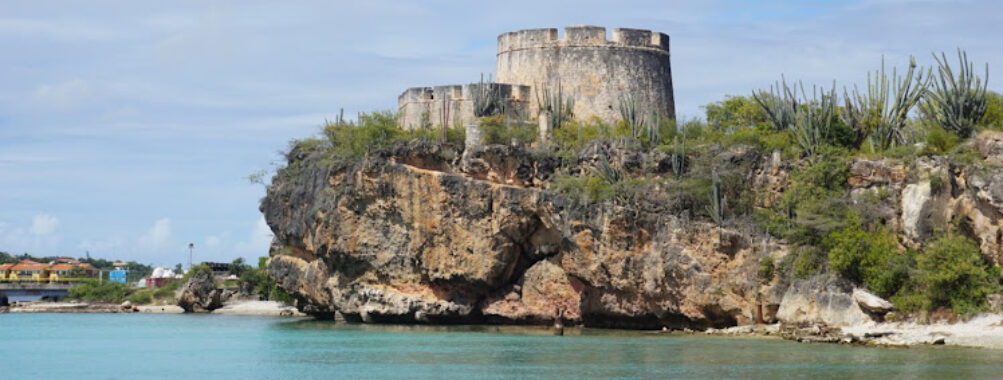
Fort Beekenburg
“`html
Table of Contents
Description
Fort Beekenburg stands proudly above the turquoise waters of Caracas Bay, a stone sentinel that has watched over Curaçao since 1703. Built by the Dutch to defend the island from pirates and rival European powers, this circular fort is one of the best-preserved examples of 18th-century military architecture in the Caribbean. The stones used to build it were actually shipped from the Netherlands as ballast—imagine that, a fortress literally carried across the ocean piece by piece. Today, it’s a quiet but powerful reminder of Curaçao’s colonial past, and honestly, it’s one of those places that still feels a bit raw and real, not overly polished or touristy.
Walking through the arched entrance, you can almost hear echoes of soldiers’ boots on the stone steps. The fort’s round tower offers sweeping sea views that make the climb worth every step (though the stairs are steep, so take your time). The cannons still sit along the ramparts, their metal darkened by centuries of salt air. Some visitors might find the place a little rugged—there’s no fancy visitor center or paved paths—but that’s part of its charm. It’s history you can touch, smell, and feel beneath your feet.
I remember my first visit—sweating under the Caribbean sun, camera in hand, trying to imagine what it must’ve been like to stand guard here 300 years ago. The fort doesn’t shout for attention; it just stands there, quietly telling its story to anyone who’s willing to listen. And if you’re the kind of traveler who appreciates authenticity over gloss, you’ll love it.
Key Features
- Built in 1703 by the Dutch to protect Curaçao from pirates and naval attacks
- Constructed with stones shipped from the Netherlands as ballast
- Round tower with panoramic views over Caracas Bay and the Caribbean Sea
- Original cannons still positioned along the fort’s ramparts
- Free entrance and open access year-round
- Located near popular beaches and snorkeling spots like Tugboat Beach
- Ideal for photography enthusiasts and history buffs alike
- Good for families, though not wheelchair accessible due to steep terrain
Best Time to Visit
If you’re planning to explore Fort Beekenburg, go early in the morning or late in the afternoon. The midday sun here can be brutal—trust me, I’ve been there, drenched in sweat by 10 a.m. The fort doesn’t offer much shade, so catching that golden hour light not only makes for better photos but also a much more comfortable experience.
The dry season, roughly from January to September, is generally the best time to visit Curaçao overall. You’ll get clear skies, calm seas, and fewer mosquitoes. But even during the wetter months, rain showers are short-lived, and the fort’s stone walls look stunning against a moody sky. If you’re lucky, you might have the whole place to yourself, with just the sound of waves crashing below.
How to Get There
Reaching Fort Beekenburg is relatively easy, especially if you’re staying near Jan Thiel or Willemstad. Most visitors drive or take a taxi—it’s about a 15-minute ride from downtown Willemstad. The road winds through a quiet coastal area before reaching the old docks of Caracas Bay. There’s no official parking lot, but you’ll find plenty of space along the roadside near the entrance.
If you’re the adventurous type, you can combine your visit with a short hike or snorkel session nearby. Tugboat Beach, just a few minutes’ walk away, is one of the island’s best snorkeling spots. I’ve done it myself—spent an hour exploring the fort, then cooled off in the water among colorful fish and coral. It’s the perfect half-day outing that blends history and nature in one go.
Tips for Visiting
A few things to keep in mind before you go. First, wear sturdy shoes. The path up to the fort is rocky, and the steps inside are uneven. Flip-flops might look tempting, but you’ll regret that choice about halfway up. Bring water, sunscreen, and maybe a hat—the Caribbean sun doesn’t play around.
If you’re into photography, bring a wide-angle lens. The fort’s circular design and open sea views make for incredible compositions. And if you’re traveling with kids, they’ll probably love exploring the tunnels and walls—it’s like a real-life pirate fort. Just keep an eye on them, as there are some steep drops and no railings.
For those who like a bit of history, take a few minutes to look up the story of Fort Beekenburg before you go. Knowing that it successfully repelled several attacks from the British and French adds an extra layer of appreciation. Standing there, you can almost feel the tension of those battles, the smoke from cannon fire drifting over the bay.
One more thing—don’t expect modern amenities. There are no restrooms, no food stalls, no ticket booths. It’s just you, the fort, and the Caribbean breeze. And that’s precisely what makes it special. It’s a place that hasn’t been overly commercialized or fenced off. You can wander freely, climb the tower, and soak in the views without feeling rushed.
If you’ve got some extra time, pair your visit with a stop at the nearby Quarantine House ruins or the small beach bars along Caracas Bay. Grab a cold drink, watch the boats drift by, and let the day slow down a little. Curaçao has a way of doing that—it invites you to pause, breathe, and just be.
In the end, Fort Beekenburg isn’t just another historical site—it’s a place that connects you to the island’s soul. It’s imperfect, a bit weathered, but full of stories. And if you stand quietly at the top of that tower, watching the waves roll in, you’ll understand why it’s still standing strong after more than three centuries.
“`
Location
Places to Stay Near Fort Beekenburg
Find and Book a Tour
Explore More Travel Guides
No reviews found! Be the first to review!